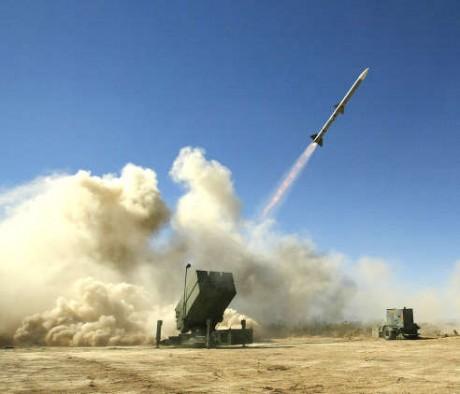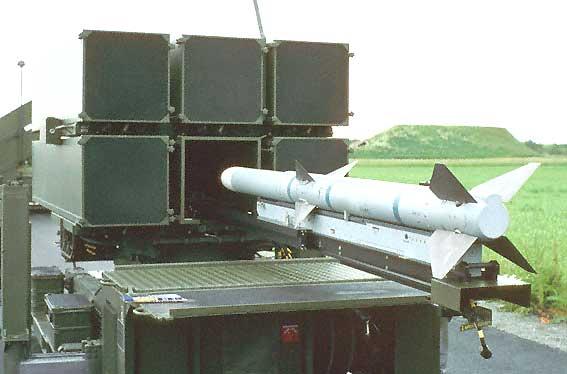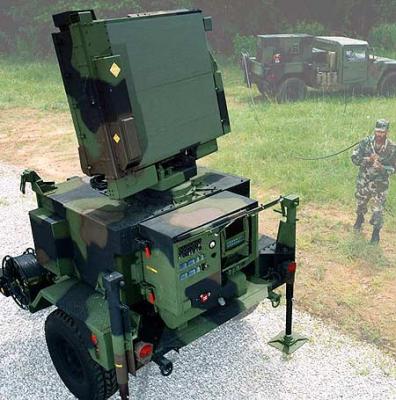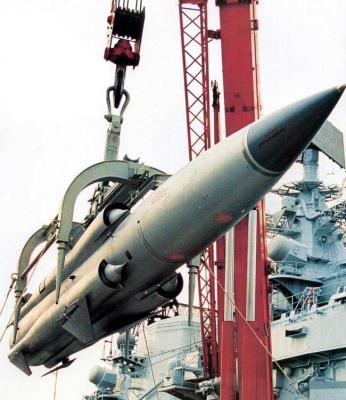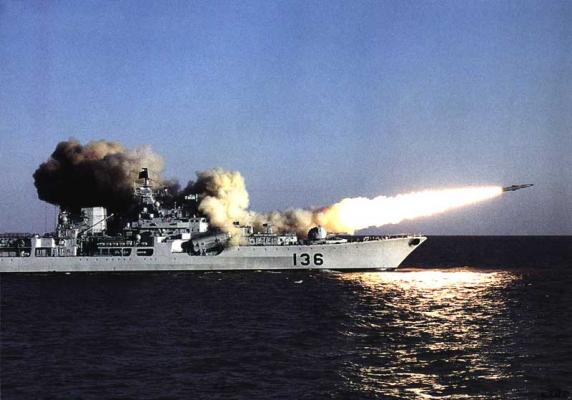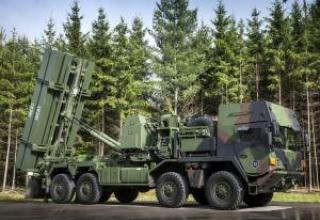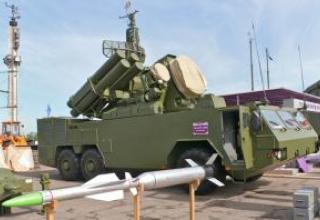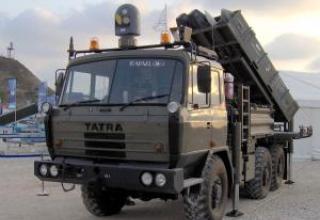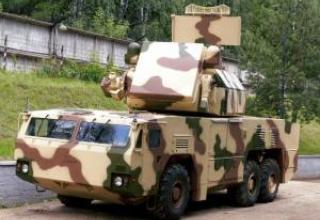Mobile anti-aircraft missile system NASAMS (Norwegian Advanced Surface-to-air Missile System) of medium range is designed to engage air targets at low and medium altitudes in all weather conditions. The complex was developed by Norwegian Kongsberg companies in cooperation with the U.S. company "Raytheon Company System" and is designed to replace the complexes "Improved Hawk" of the Norwegian Armed Forces.
The development of the complex was started in 1989 and finished in 1993 with polygon tests. Since 1994, the SAM system has been in service with the Norwegian Air Force. To reduce the cost of NASAMS SAM systems, its development was widely used the principle of modernization and harmonization of the complex elements with existing weapons systems. AMRAAM" missile was used as a means of destruction. (AIM-120A) air-to-air class by Raytheon Company System. For target detection and fire control, an upgraded version of the AN/TPQ-36A three-axis radar and the Improved Hawk - NOAH (Norwegian Adapted Hawk) fire control system are used.
In terms of combat capabilities, the NASAMS system is superior to the Improved Hawk SAM system. NASAMS is capable of simultaneously escorting and hitting more targets, reduced reaction time and transfer of the complex from camping to combat. The number of service personnel is reduced by four times, it has a greater degree of equipment unification and the ability to interface with other systems.
The cost of developing and deploying by 1999, six batteries of NASAMS SAM system, according to calculations of Western experts, is 250 million dollars. The batteries are used for air defense of the main air bases in Norway.
Since 1999, an upgraded complex, which received the designation NASAMS II, goes into service of the air defense units of the Norwegian Land Forces. Since 2004, this SAM system is in service with the U.S. and is used for air defense of Washington. In 2005, the NASAMS system was purchased for the Spanish Armed Forces. The system was also purchased by the Netherlands, Chile, Finland, Oman, Lithuania, Indonesia and Qatar.
Composition:
The rocket (AIM-120A) is made according to the normal aerodynamic scheme and has a cross-shaped wing of a small area, which provides quite good maneuverability even at low flight speeds, and cross-shaped rudders in the tail end. The LSD is controlled by a combined guidance system: command-inertial on the initial flight path and active radar homing on the final one. If the target does not manoeuvre, the missile performs an autonomous flight using the inertial unit on the trajectory stored in the memory of the on-board computer before launch. In case of target maneuvering, correction commands are given from the ground to the LRS according to the change in the current target coordinates. The commands are received by the onboard receiver of the command communication line, the antenna of which is located on the nozzle block of the missile. The target is captured by the radar homing head of the LRS at a distance of up to 20 km, after which it is actively homing. The missile is equipped with a fast microcomputer operating with a clock frequency of 30 MHz and a memory capacity of 56,000 16-bit words.
The missile is equipped with a shrapnel-array directional warhead detonated by an active radar or contact fuse.
SAMs are stored, transported and launched from transport and launch containers. A package of six such containers is placed on a launcher made on the chassis of a Scania P113 cross-country vehicle (4x4+2 wheel arrangement). In the Spanish army, the launcher is made on "Iveco" chassis (see photo). Rockets are loaded into the TPC by means of a charging vehicle, which is part of the complex (see photo). The missiles are launched at a fixed angle of 30°. In the camping position, the transport and launch containers with SSD are placed horizontally. In order to increase the survivability of the complex, it is assumed that the PU from the control point and radar positions will be dispersed at a distance of up to 25 km, and communication with the installations can be organized via cable, fiber-optic or digital communication lines. Thales Communication equipment based on TAS 300 (Tactical Eurocom switch) provides high-speed exchange, encoding and decoding of traffic between network nodes, interface with STANAG 4206 and ISDN networks.
The multifunctional radar AN/TPQ-64, developed on the basis of AN/TPQ-36A artillery position detection radar, provides detection, identification and simultaneous tracking of up to 60 air targets, as well as pointing up to three SAMs at selected of them. The AN/TPQ-64 radar is a pulsed Doppler, three-axis radar, equipped with a phased array antenna and an integrated Mk.XII "in-situ" requestor. The radar provides space overview by means of mechanical rotation of the antenna along the azimuth and electronic scanning along the angle of the place. The work of the radar is controlled by the computer of the fire control station. The radar generates a needle-type directional diagram with low side lobes and is capable of compressing pulses, selecting moving targets, changing the power and type of the signal emitted. Radar operates in the range of frequencies 8-10 GHz (azimuth view area - 360 °, angle of place - 60 °, the rate of view on azimuth - 180 ° per second, the accuracy of determining the coordinates of the range - 30m, azimuth - 0.2 °, angle of place - 0.17 °, the resolution of the range of 150m, azimuth - 2 °, angle of place - 1.7 °). The time of deployment and preparation for work - 10 minutes. All station equipment is installed on a towed trailer.
To ensure combat operations in a complex interference environment NASAMS complex is equipped with optoelectronic guidance - NTAS (Norwegian Tracking Adjunct System).
Information about the air situation from the radar (data update period - 2 s) is transmitted to the fire control station, which consists of two high-performance computers, multi-purpose console of modular design with display and control systems, data transmission equipment and communication facilities (see photo). The console has two duplicate automated workstations (AWPs) with the same controls. Each ARM is equipped with three displays, two of which display the entire air and combat situation, and the third one shows the status and readiness of the complex systems. Detailed information about the direction of movement, speed and height of any target can be obtained by the operator by entering the azimuth marker and pressing the data read button to display them on the display screen.
The fire unit of the complex is a platoon with three PU with six missiles each, a multifunction radar AN/TPQ-64 and a fire control station. The main tactical unit of NASAMS SAM system - battery. It consists of three fire platoons (a total of 54 missiles), combined into an information network so that each of the three radars can replace all the others. The battery command post (located at one of the fire control points) can receive target designation from the superior headquarters and provide air situation data to the platoon fire control points. All 54 missiles can be fired at different targets within 12 seconds.
NASAMS II complex differs from the prototype in greater mobility - NASAMS II launchers are mounted on a cross-country chassis type Bv 206. The battery includes 4 platoons instead of three, six radars AN/TPQ-64 instead of three and 12 launchers instead of nine. NASAMS II software is compatible with communication systems used by the Norwegian ground forces.
Characteristics:
| Complex NASAMS | |
| Defeat range, km | 2.5-25 |
| Defeat height, km | 0.03-16 |
| Probability of hitting the target with one missile | 0.85 |
| The reaction time, s | 10 |
| Time of transfer from combat to camping, mines | 3 |
| Time to move from camping to combat, mines. | 15 |
| Maximum target speed, m/sec. | 1000 |
| AIM-120A rocket | |
| Mass of the rocket, kg | 150.7 |
| Weight of combat unit, kg | 22 |
| The length of the rocket, m | 3.66 |
| Hull diameter, m | 0.178 |
| Maximum rocket speed, m/s | 1020 |
| Own permissible missile overload | 40g |
| RADAR AN/TPQ-64 | |
| Instrumental detection range, km | 75 |
| Fighter target detection range, km | 60 |
| Operating frequency range, GHz | 8-10 |
| View area by azimuth, degree | 360 |
| View area by angle of place, degree | 60 |
| Azimuth view rate, deg./s. | 180 |
| Accuracy of distance coordinates, m | 30 |
| Precise azimuth coordinate determination, degree | 0,2 |
| Accuracy of position by angle, degree | 0.17 |
| Range resolution, m. | 150 |
| Azimuth resolution, deg. | 2 |
| Resolution by angle, degree. | 1.7 |
| Average time worked on failure, h | 300 |
Testing:
Tests of "Moskit" complex started in June 1978 at "Sandy Beam" range. The flight and design tests began with two throw launches on June 9 and October 10, 1978. The mock-up of the rocket was equipped only with the starting engine. Both launches were normal. Then came a long break, mainly due to the unpreparedness of the material part of the rocket, in particular, the marching engine, which was difficult to be brought to the manufacturer.
On December 29, 1979 a model equipped with a marching engine was launched. The launch was unsuccessful, as the marching engine was not launched, and the starter remained in the nozzle block of the marching engine after development. After the start, a timeout was taken again to rework the marshal engine. The next launch took place only on July 3, 1980. The task of the launch was to get a reliable start of the rocket and make a flight at an altitude of about 20m. The launch was considered to be successful, but the marching engine never reached the design mode.
January 27, 1981 the rocket "Moskit" for the first time was launched in full configuration, but without turning on the active channel combined CNS. The rocket was to hit the target SM Pr.1784 at a distance of 38 km. The launch was unsuccessful due to instability of the onboard control system. At launch on April 28, 1981 a task similar to the previous launch was set. Direct hit to the target was achieved. On June 2 there was shooting at two targets - SM pr. On June 2 there was firing at two targets - SM Pr. 1784 and BKShP No. 436 bis at the distance of 38 km without switching on the active channel of combined GSN. The launch was successful and a direct hit to a larger target, SM, 1784 Pr. was achieved.
By the beginning of June 1981 a new modernized target SM Pr.1784 arrived to provide flight tests of ZM-80 missiles. 1784M Prospect, manufactured in Nikolaev. On this target, as well as on the old SM Ave. The whole system of radar reflectors in the amount of about 50 pieces of different types (K-0.7, K-1.25, etc.) and a thermal imitator "Balancer" working on household gas propane-butane were left on this target, only instead of one burner there were two (it was believed that a big ship - a battleship, a cruiser or an aircraft carrier - had at least two radiation centers). The target of the CM Ave. At the SM target of 1784M Ave. the system of external trajectory measurements was fundamentally improved. Previously, the film camera and photo equipment, shooting the missile approach to the target, were installed "on the eye", and now the film camera was tied to the target itself with a high degree of accuracy. The camera viewing angles were chosen so that they necessarily included some element of the target structure in addition to the missile. In order to test the operation of the active channel of the combined RS on a ZM-80 missile on the SM target, the cameras were designed to be able to detect the target. 1784M was equipped with a special system called "Minaret". The system included "Don" radar with a modified antenna system, remote control system for television signaling and telecommunications, equipment for documentation of operating modes, etc. In addition, two "Puck" and "Rynda" systems were installed, which determined the missile miss rate. The "Puck" system determined the magnitude of the miss relative to its antenna, and the "Rynda" system determined the magnitude of the miss relative to the so-called "reduced target". The target also had a well-equipped cockpit to accommodate the team. On June 26, 1981, two targets were fired - SM Pr.1784M, set from the starting point at a distance of 40 km, and on the BKShchina Pr.436 bis, set from the starting point at a distance of 10 km. The missiles were launched with active and passive CNS channels connected. The launch was considered successful. The missile hit the SM target at 436bis Ave. 1784M (pierced the target grid at 1.0m from the deck) and was driven 80km from the launch point. This launch ended the program of flight and design testing of the Moskit complex.
Launches under the program of joint (state) testing began in August 1981. At this stage of testing, the missiles were launched both from the coastal launcher and from a large missile boat of project 1241.1 (plant № 402) and destroyers of project 956 "Modern" (plant № 861) and "Desperate" (plant № 862). The first launch under the joint testing program took place on August 21 from the coastal launcher on target SM of 1784M pr.1784M to the range of 102 km. The task of the launch was to check the operation of all units and assemblies. Direct hit to the target was achieved. On September 30 it was launched from the boat of project 1241.1. The model of the rocket was equipped only with a starting engine. The mock-up was launched normally from the boat, which ran at a speed of 24 knots. when the sea waves 2-3 points. After that, the boat with the factory number. 402 was allowed to participate in joint testing of the Moskit complex.
On October 2, 1981 the launch was made with the task similar to the launch on August 21, but this time the target was not exposed. The launch was considered successful.
On November 24th the boat of project 1241.1 was launched from the target of SM Pr. On November 24th it was launched from the boat of the project 1241.1 on the SM target of 1784M pr. for the range of 100 km. The launch ended in failure due to a malfunction in the onboard control system. The rocket fell into the sea on the 10th second after the launch.
On December 27, 205 and 305 missiles were fired in volley from the boat of 1241.1 Ave. at two targets - BKShchinskaya Ave. 436 bis and SM pr. 1784М. The distance to the target of the BKSh was 10 km. Missile No 205 was aimed at this target. The launch was considered successful - a direct hit to the target was achieved. The range to the SM target was 33km. Missile No. 305 was to be aimed at this target. The launch was unsuccessful - the covers of the air intakes of the marching engine did not open, and the missile was brought to 23.7 seconds of flight. The interval between launches was 5 seconds.
On April 14, 1982 the missile was launched from the shore-based installation on the target of the SM Ave. 1784M Ave. at a distance of 100 km. The launch was unsuccessful. The missile fell at the 24th km distance due to malfunctions in the onboard control system.
On April 29, the first launch from the destroyer of the project 956 "Modern" in the Northern Fleet on the target of OS-111 (trawler project 265K) at a distance of 141 km was made. The launch was successful - a direct hit to the target superstructure was achieved. May 26, 1982 volley firing of rockets № 106 and № 505 from the destroyer "Modern" on the target of OS-111 at a distance of 35.5 4 m was carried out. Both missiles with equipment for the combat unit TC-22 were simultaneously launched from both sides of the destroyer. Rocket number 505 hit the target, hitting its superstructure. Rocket number 106 did not lower the flight height in front of the target, flew over it at an altitude of 17 m from the waterline and flew 47.5 km. The shooting was found to be partially successful. But the rocket number 106 could have flown not 17 m above the waterline, but 170 m, still with the presence of TC-22 ship would not have seemed a little Yankee.
On August 31, 1982, it was launched from the boat of project 1241.1 at a distance of 100 km with a 50-target position after the launch from two targets of OS-111 and SM pr. 1784М. The launch was unsuccessful - the marching engine was not launched and the missile fell into the sea at a distance of 12.8 km from the boat.
September 15 was a repeat of the previous launch. On September 15, it was a repeat of the previous launch. 1784M Ave. and hit it. The actual range of fire was 107.7 km.
On September 29 the boat of project 1241.1 was launched from the boat to the range of 27 km at the target of OS-1.11. A direct hit was achieved, the target sank.
November 28, volley firing of rockets ¹ 306 and ¹ 506 was made from the destroyer of project 956 "Desperate" in the Barents Sea in the Northern Fleet. (Shots were fired in parallel with the ship's delivery tests.) The target range of the target was set at the SM Ave. 1784 was 27 km. The speed of the ship during the launch was 20 knots. Firing was carried out from the starboard launcher, the interval between launches was 5 seconds. The target was hit by both missiles.
This was the end of the joint testing of the Moskit complex. In the course of these tests conducted 15 launches (14 missiles and 1 mock missile). According to the decision of the State Testing Commission, there were 8 fully successful launches, 5 partially successful launches and 2 unsuccessful ones.
In the period from 1983 to 1988, there were three types of tests of the Moskit complex. Firstly, tests on improvement of tactical and technical characteristics, ZM-80 missiles were conducted. In total, there were three launches: March 11, 1983, June 29, 1983. (mock missile) and December 7, 1984. At this stage, the flight range of 125 km was achieved.
Since the early 1980s, the possibility of installing the Moskit complex on the Lunar screen of Project 963 was considered. For this purpose, a mock-up of the screen plan of project 903 was installed at the "Sandy Beam" range in the village of Chernomorsk. The main purpose of the tests was to check the ability of the screen plan design to withstand the force and heat of the starting engine jet. On October 5 and December 21, 1984 two launches of "Moskita" mock-ups equipped only with starting engines were held. The first launch was made from the right container of the bow pair of launchers, and the second launch - from the left container of the tail pair of launchers. Since there were only two containers, the nose pair stood in its place at the first start and then it was moved to the tail. During these tests were tested two options for loading missiles on the screen, the first version of the rocket was loaded into a container already installed on the screen, using the loading device, the second version of the rocket was loaded into a container located on the ground, and then the entire structure was installed on the screen. All launches went smoothly. After the first launch 9 tiles were damaged, after the second one - 2. There were two launches of ZM-80 missiles in the Caspian Sea. The target was the BKShchy Ave. 436bis. The first launch was unsuccessful due to crew errors. During the second launch there was a double salvo (at an interval of 5 seconds). The launch was counted as successful.
Sources:
- Василин Н.Я., Гуринович А.Л. "Зенитные ракетные комплексы" .-Мн.: ООО "Попурри", 2002- 464с.
- Norwegian NASAMS
- Surface to air missile non-comparision table
- Royal Norwegian Air Force
- Army Technology - Thales Communications AS - Secure Tactical and Strategic Communications Systems
- NASAMS
